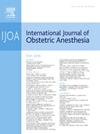脊柱麻醉下剖宫产血压管理:英国多中心审计(2023)
IF 2.6
3区 医学
Q2 ANESTHESIOLOGY
引用次数: 0
摘要
背景:剖宫产脊髓麻醉后交感神经阻滞治疗可引起重度低血压。国家健康与护理卓越研究所(NICE)指南建议收缩压(SBP)应维持≥基线的90%。这项多中心审核评估了脊柱麻醉下剖宫产时血管加压药的选择和给药方法的依从性。方法对英国西米德兰兹郡脊髓麻醉下剖宫产的成年患者进行多中心前瞻性审计。在常规围手术期护理期间获得匿名患者数据,并对主要、过程和临床结果进行审计。主要审计结果是术中收缩压维持在≥90%基线。结果共纳入526例患者。9.1%的病例达到了主要结局。65.0%的患者收缩压维持在基线的80-90%,25.9%的患者收缩压低于基线的80%。在91%的病例中,苯肾上腺素是一线血管加压药,73.8%的病例通过速率控制装置给药。通过速率控制装置以25-50 μg/min使用预防性苯肾上腺素,符合国际共识建议的比例为37.6%。临床报告的术中恶心和呕吐发生率分别为24.9%和8.4%。二次分析发现,使用速率控制泵装置给予预防性血管加压药物与收缩压发生率降低至基线的80%相关(P <0.01)。结论术中低血压较为常见,但缺乏对指导的坚持,包括预防性血管加压药物的选择和给药方法存在差异。低血压的最佳管理应纳入部门指导,以促进恢复。本文章由计算机程序翻译,如有差异,请以英文原文为准。
Blood pressure management for caesarean delivery under spinal anaesthesia: a UK multi-centre audit (2023)
Background
Untreated sympathetic blockade after spinal anaesthesia for caesarean delivery can cause profound maternal hypotension. National Institute for Health and Care Excellence (NICE) guidance recommends systolic blood pressure (SBP) should be maintained ≥90% of the baseline. This multi-centre audit assessed compliance with guidance regarding choice and administration method of vasopressors during caesarean delivery under spinal anaesthesia.
Methods
A multi-centre prospective audit of adult patients undergoing caesarean delivery under spinal anaesthesia was undertaken across the West Midlands, UK. Anonymised patient data was obtained during routine peri-operative care and audited across primary, process and clinical outcomes. The primary audit outcome was maintenance of intra-operative SBP at ≥90% baseline.
Results
Five-hundred-and-twenty-six patients were included. The primary outcome was achieved in 9.1% of cases. SBP was maintained within 80–90% of baseline in 65.0%, and below 80% of baseline in 25.9%. Phenylephrine was the first-line vasopressor in 91% of cases, administered via a rate-controlled device in 73.8%. Compliance with the international consensus recommendation for prophylactic phenylephrine via a rate-controlled device at 25–50 μg/min was 37.6%. Clinician-reported incidence of intra-operative nausea and vomiting were 24.9% and 8.4% respectively. Secondary analysis found that use of rate-controlled pump devices to administer prophylactic vasopressors was associated with reduced incidence of SBP decrease to <80% of baseline (P <0.01).
Conclusions
Intraoperative hypotension is common, and there is lack of adherence to guidance, including variation in choice and administration method of prophylactic vasopressors. Optimal management of hypotension should be incorporated into departmental guidance for enhanced recovery.
求助全文
通过发布文献求助,成功后即可免费获取论文全文。
去求助
来源期刊
CiteScore
4.70
自引率
7.10%
发文量
285
审稿时长
58 days
期刊介绍:
The International Journal of Obstetric Anesthesia is the only journal publishing original articles devoted exclusively to obstetric anesthesia and bringing together all three of its principal components; anesthesia care for operative delivery and the perioperative period, pain relief in labour and care of the critically ill obstetric patient.
• Original research (both clinical and laboratory), short reports and case reports will be considered.
• The journal also publishes invited review articles and debates on topical and controversial subjects in the area of obstetric anesthesia.
• Articles on related topics such as perinatal physiology and pharmacology and all subjects of importance to obstetric anaesthetists/anesthesiologists are also welcome.
The journal is peer-reviewed by international experts. Scholarship is stressed to include the focus on discovery, application of knowledge across fields, and informing the medical community. Through the peer-review process, we hope to attest to the quality of scholarships and guide the Journal to extend and transform knowledge in this important and expanding area.

 求助内容:
求助内容: 应助结果提醒方式:
应助结果提醒方式:


